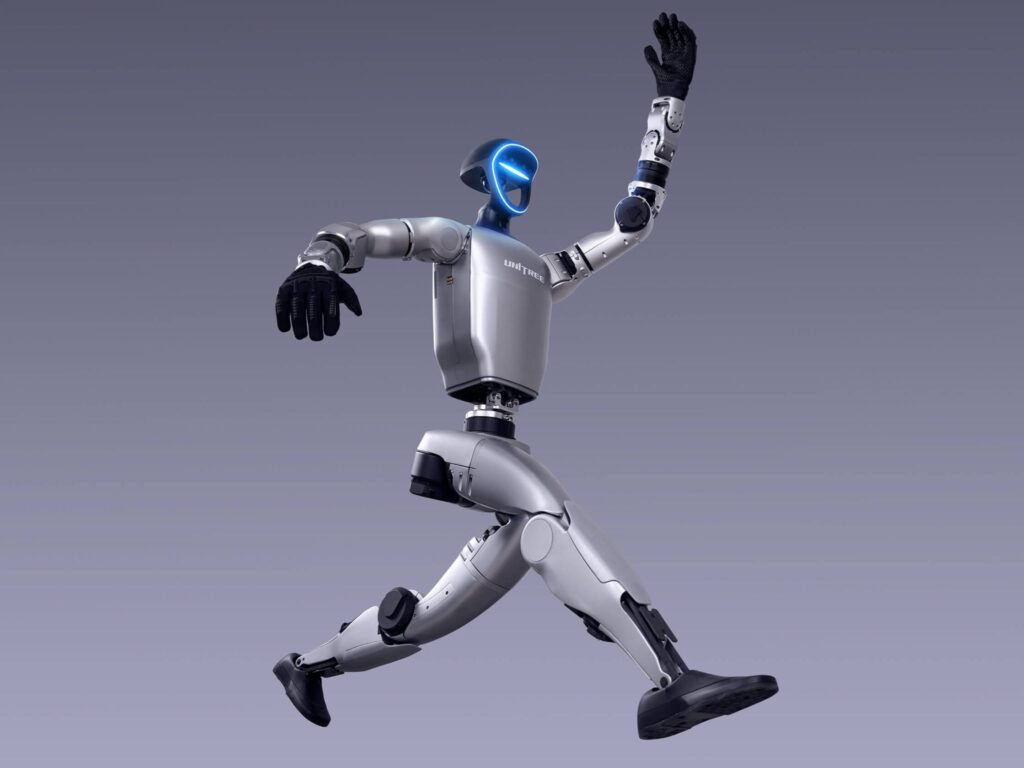
The Unitree G1 humanoid robot is turning heads in the world of robotics—offering advanced hardware, AI-driven control and design that hints at what the future of personal and industrial robots might look like. Whether you’re a tech enthusiast, researcher or just curious about robotics, the G1 is worth a closer look. Here’s what makes it exciting, what it can (and can’t) do, and why it might matter.
The G1 is a humanoid robot platform developed by Unitree Robotics. According to specs on the company site:
Dimensions when standing: roughly 1,320 mm tall (about 4.3 ft), with footprints around 450 × 200 mm. 宇树科技—全球四足机器人行业开创者
Weight: about 35 kg (for one configuration) with battery included. 宇树科技—全球四足机器人行业开创者
Degrees of freedom: 23 in standard model, with arms, legs, waist joints all driven, giving it a high level of mobility and flexibility. 宇树科技—全球四足机器人行业开创者
It features three-fingered hands (in optional configurations) with “force-position hybrid control”, enabling delicate manipulation of objects. 宇树科技—全球四足机器人行业开创者
Basic computing inside: high-performance CPU (8-core), plus depth camera + 3D LiDAR, WiFi 6, Bluetooth 5.2. 宇树科技—全球四足机器人行业开创者
Price: From ~$13,500 USD (for some models) excluding tax/shipping. 宇树科技—全球四足机器人行业开创者
In short: this is a serious humanoid platform aimed at research, prototyping and advanced applications. Not just a toy or novelty.
Until recently, humanoid robots with this level of freedom and feature-set were massively expensive (think six-figures for buying or developing). The G1’s price relative to the specification signals a shift: more accessible platforms for labs, universities, research corps. This could spur more innovation collectively.
The G1 doesn’t just have many joints or cool arms—it’s built to integrate with AI models (Unitree references a unified world-model for robotics control). 宇树科技—全球四足机器人行业开创者+1 That means the robot is designed to learn tasks, adapt, possibly work alongside humans or in dynamic environments.
Whether for research in robotics, industrial automation, human–robot collaboration or even entertainment, the G1 opens up possibilities. A humanoid that can handle manipulation (hands), mobility, perception (LiDAR/cameras) means more domains than just locomotion.
Here’s a deeper dive into what the G1 offers and how it feels in practice.
Mobility & body movement: With its 23 DOF (and optional up to 43 in upgraded versions) the robot can handle complex movement—legs, arms, waist. That gives richer behaviour than simpler robots. 宇树科技—全球四足机器人行业开创者+1
Manipulation: The optional three-fingered hands with force-position control allow the robot to pick up, handle, possibly manipulate objects with a level of finesse. This opens up functional tasks, not just walking. 宇树科技—全球四足机器人行业开创者
Sensors & perception: With depth cameras and LiDAR, the G1 has spatial awareness. That’s key for autonomous or semi-autonomous tasks in real environments. 宇树科技—全球四足机器人行业开创者+1
Software & ecosystem: Unitree provides a platform (G1-D variant) for data acquisition, training models and development. 宇树科技—全球四足机器人行业开创者
Compact form / foldable dimension: The G1 can “fold” or collapse to a smaller dimension (690 × 450 × 300 mm) in some configuration for storage/transport. 宇树科技—全球四足机器人行业开创者
In short: the hardware spec is compelling. But the user experience and real-world usability will depend on how software, reliability, safety, and user workflows are built.
Every cutting-edge platform comes with trade-offs, and the G1 is no exception.
Battery life & endurance: With complex joints, sensors, compute, the runtime is limited. The spec says approx. 2 hours under standard conditions. 宇树科技—全球四足机器人行业开创者
Maturity & task-readiness: While the robot has many capabilities, using it for real tasks (household chores, industrial automation) still requires software, development, task definition. A news article highlights it “needs to be taught how to make breakfast.” The Verge
Cost and accessories: The ~$13,500 base price is lower than many humanoids—but still significant. Accessories, customization, software add up.
Reliability & real-world readiness: Not all environments are lab-style; accidents, maintenance, durability remain concerns. Also, despite the strong spec, human-level generality isn’t here yet.
Ethics & safety: Robots that move and manipulate in human spaces bring concerns of safety, regulation, liability. Especially humanoids.
Support ecosystem: For labs and businesses, support, spare parts, software updates matter. Early adopters must be comfortable with some unknowns.
Robotics research labs / universities: This is a platform with serious hardware and ecosystem support—useful for research in locomotion, manipulation, human–robot collaboration, embodied AI.
Companies exploring automation / human-robot workflows: If you’re investigating how humanoids might join industrial operations, customer service, or dynamic tasks, G1 gives a base.
Hobbyists/enthusiasts with deep interest and budget: If you have the space, expertise and budget, the G1 offers a high-end platform unlike many hobby robots.
Integration & solution providers: Firms building robot solutions could use the G1 as a base, customize it for specific environments.
It might be less suited for: casual users wanting a “robot assistant” immediately doing household chores out of the box, due to the development required.
The Unitree G1 is a remarkable step in the humanoid robotics field—bringing strong specs, AI integration and a more affordable bridge into what was once only high-end lab hardware. It’s not yet a robot butler that handles everything in your home, but it is a serious platform for R&D, advanced automation, and exploring the future of embodied intelligence.
If you’re excited about where robotics is going—even if all the pieces aren’t perfect yet—the G1 is one of the most compelling humanoid platforms available right now. As software develops, battery tech improves and ecosystems mature, platforms like this could become more mainstream. For now, it remains a thrilling glimpse into the next generation of intelligent machines.